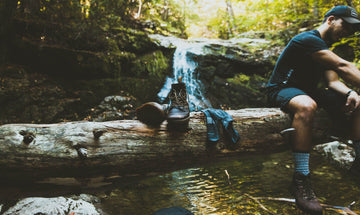6 Tips On How to Choose the Best Socks for Your Outdoor Activities
by Emily Jannet on Mar 29, 2023
As outdoor enthusiasts, we understand the importance of having the right gear for our outdoor activities. While we often focus on choosing the right shoes, jackets, and backpacks, we may overlook the importance of choosing the right socks. Socks play a critical role in keeping our feet comfortable, dry, and protected during outdoor activities. In this blog post, we will provide you with tips on how to choose the best socks for your outdoor activities.
1. Material
The material of your socks is essential for your comfort and the health of your feet. Different materials offer different benefits, and it's essential to choose the right material based on your activity, weather, and personal preference. Here are some common sock materials used in outdoor activities:
Wool: Wool is a popular material for outdoor socks because of its natural insulation and moisture-wicking properties. Wool keeps your feet warm even when wet, and it's comfortable for extended wear.
Synthetic: Synthetic materials like polyester and nylon are popular for their durability and quick-drying properties. These materials are ideal for activities that involve a lot of sweating or water exposure.
Cotton: While cotton is comfortable and breathable, it's not recommended for outdoor activities because it retains moisture, which can lead to blisters and discomfort.

2. Cushioning
The cushioning of your socks is essential for providing support and reducing fatigue during long hours of outdoor activities. The amount of cushioning you need depends on the activity and the terrain. Here are some common cushioning levels for outdoor socks:
Light cushioning: Light cushioning is ideal for low-impact activities like walking and hiking on flat terrain. It provides some padding and support without adding extra weight or bulk.
Medium cushioning: Medium cushioning is ideal for moderate activities like hiking on uneven terrain. It provides extra padding and support for your feet and helps reduce fatigue.
Heavy cushioning: Heavy cushioning is ideal for high-impact activities like mountaineering and backpacking. It provides maximum padding and support for your feet and helps absorb shock.
3. Moisture-Wicking
Moisture-wicking is essential for keeping your feet dry and comfortable during outdoor activities. When your feet are wet, they are more prone to blisters, infections, and discomfort. Moisture-wicking socks are designed to pull moisture away from your feet and allow it to evaporate quickly. Look for socks that have moisture-wicking properties, especially if you are planning to engage in activities that involve a lot of sweating or water exposure.
4. Compression
Compression socks are designed to apply pressure to your legs and feet, promoting blood flow and reducing swelling. They are popular among athletes and outdoor enthusiasts who engage in high-impact activities. Compression socks come in different levels of pressure, and it's essential to choose the right level based on your activity and personal preference.
5. Choosing the Right Size
Choosing the right size for your socks is crucial for your comfort and performance during outdoor activities. Socks that are too small can cause discomfort and blisters, while socks that are too big can bunch up and cause friction. Make sure to measure your feet and choose socks that fit snugly but not too tight. It's also essential to consider the shape and length of the sock. Some socks come in different shapes and lengths, and it's essential to choose the right one based on your activity and footwear.
6. Choosing the Right Style
Choosing the right style for your socks is not just about aesthetics, but also about function. Different styles of socks offer different benefits, and it's essential to choose the right style based on your activity and personal preference. Here are some common styles of outdoor socks:
Ankle socks: Ankle socks are low-cut socks that sit below the ankle bone. They are ideal for low-impact activities like walking and running and are popular among athletes.
Crew socks: Crew socks are medium-length socks that sit above the ankle bone and below the calf muscle. They are ideal for hiking and other outdoor activities that involve moderate impact and uneven terrain.
Knee-high socks: Knee-high socks are long socks that sit above the calf muscle and below the knee. They are ideal for high-impact activities like mountaineering and backpacking and provide extra support and protection for your legs.
All in All
Choosing the right socks for your outdoor activities can make a significant difference in your comfort, performance, and overall experience. Consider the material, cushioning, moisture-wicking, compression, size, and style of your socks when choosing the right pair. With the right socks, you can enjoy your outdoor activities with comfort and confidence, no matter where life takes you.





